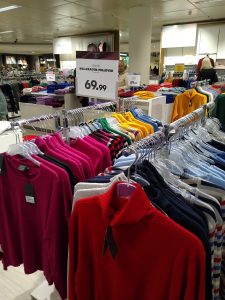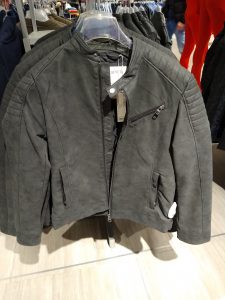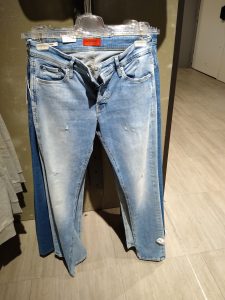Einheit 3.6 (online)
 |
 |
 |
![]() Übung 1
Übung 1
![]() Grammatik
Grammatik
Adjective Endings in Nominative
Adjectives take an ending when they come directly before the noun they describe. The adjective endings vary depending on the gender, number, and case of the noun which they describe.
In the nominative case, if the adjective is preceded by a der-word (e.g., definite article, “dies-“, “jed-“, “welch-“), the ending for masculine, feminine, and neuter is -e, and the ending for plural is -en.
| masculine | feminine | neuter | plural |
| der rote Rock | die weiße Bluse | das blaue Hemd | die schwarzen Schuhe |
Der blaue Mantel kostet 80 Euro.
Das gelbe Sakko ist alt.
Die braunen Stiefel kosten 120 Euro.
However, if the adjective is preceded by an ein-word (e.g., indefinite article, “kein”, or any possessive determiner mein, dein, sein/ihr/sein, unser, euer, ihr/Ihr), the adjective endings are different. You will need to learn both charts.
| masculine | feminine | neuter | plural |
| ein roter Rock | eine weiße Bluse | ein blaues Hemd | keine schwarzen Schuhe |
Das ist ein grauer Hut.
Das sind meine neuen Sandalen.
Please note that the adjective ending will apply to all adjectives preceding the noun. For example:
Der lange rote Rock ist neu.
Das ist ein schönes blaues Kleid.
Meine neuen warmen schwarzen Schuhe sind teuer.
*Achtung* The colours “rosa” and “lila” don’t take any adjective endings in the nominative (e.g., der rosa Rock, die lila Bluse, etc.)
![]() Übung 2
Übung 2
![]() Grammatik
Grammatik
“dies-“/”jed-“/”welch-“
The words “dies-“ (this), “jed-“ (every, each), and “welch-“ (which) take the same endings as the definite articles that we learned in Einheit 1. Look at the following examples:
Dieser Pullover ist sehr schön.
Diese Bluse ist zu klein.
Dieses Kleid ist hässlich.
Diese Socken sind schmutzig.
Nominative case:
| masculine (der) | feminine (die) | neuter (das) | plural (die) |
|
dieser Pullover jeder Pullover welcher Pullover? |
diese Bluse jede Bluse welche Bluse? |
dieses Kleid jedes Kleid welches Kleid? |
diese Socken welche Socken? |
Accordingly, when you use one of these words together with an adjective, the adjective endings are the same as in the table above when they are used with definite articles.
Dieser schöne blaue Pullover ist neu.
Welche rote Bluse ist teurer?
Jedes karierte Hemd ist altmodisch.
Welche alten Socken haben Löcher?
![]() Übung 3
Übung 3
![]() Übung 4
Übung 4
*Achtung*
You heard these sentences in the listenings:
Ja, ich suche eine neue Hose.
Diese Jeans kostet nur 39 Euro.
Please note that “die Hose”, “die Jeans” and “die Brille” are singular. There are plural forms as well.
Die Hosen sind teuer.
Die Jeans kosten mehr als die Jogginghosen.
![]() Wortschatz in Quizlet:
Wortschatz in Quizlet:
![]() Was wissen Sie jetzt? Klicken Sie hier für Quiz 3.6.
Was wissen Sie jetzt? Klicken Sie hier für Quiz 3.6.
Extra Practice (optional):
![]() Deutschtrainer
Deutschtrainer
If you want to practice vocabulary from todays lesson, click on the topic below. Watch the video and then click on “start” under the video and do the exercises.
Media Attributions
- Rollkragen-Pullover © ckost is licensed under a CC BY-NC-SA (Attribution NonCommercial ShareAlike) license
- Lederjacke © ckost is licensed under a CC BY-NC-SA (Attribution NonCommercial ShareAlike) license
- Jeans © ckost is licensed under a CC BY-NC-SA (Attribution NonCommercial ShareAlike) license
- star © IO-Images is licensed under a Public Domain license
- link © IO-Images is licensed under a Public Domain license
- check mark © janjf93 adapted by Solomon Hajramezan is licensed under a Public Domain license
plaid
holes

